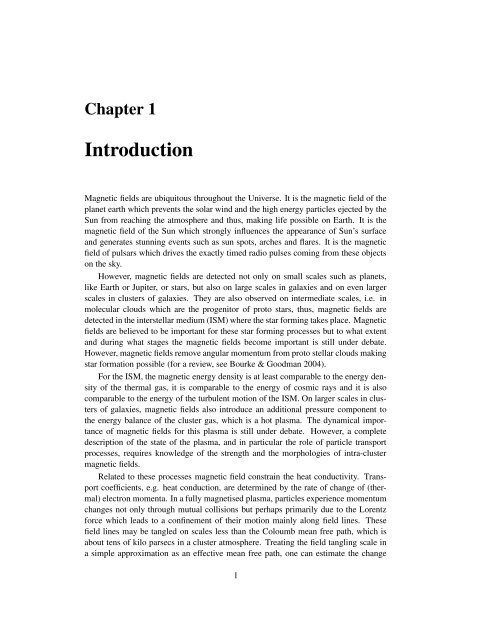Investigations of Faraday Rotation Maps of Extended Radio Sources ...
Investigations of Faraday Rotation Maps of Extended Radio Sources ...
Investigations of Faraday Rotation Maps of Extended Radio Sources ...
Create successful ePaper yourself
Turn your PDF publications into a flip-book with our unique Google optimized e-Paper software.
Chapter 1<br />
Introduction<br />
Magnetic fields are ubiquitous throughout the Universe. It is the magnetic field <strong>of</strong> the<br />
planet earth which prevents the solar wind and the high energy particles ejected by the<br />
Sun from reaching the atmosphere and thus, making life possible on Earth. It is the<br />
magnetic field <strong>of</strong> the Sun which strongly influences the appearance <strong>of</strong> Sun’s surface<br />
and generates stunning events such as sun spots, arches and flares. It is the magnetic<br />
field <strong>of</strong> pulsars which drives the exactly timed radio pulses coming from these objects<br />
on the sky.<br />
However, magnetic fields are detected not only on small scales such as planets,<br />
like Earth or Jupiter, or stars, but also on large scales in galaxies and on even larger<br />
scales in clusters <strong>of</strong> galaxies. They are also observed on intermediate scales, i.e. in<br />
molecular clouds which are the progenitor <strong>of</strong> proto stars, thus, magnetic fields are<br />
detected in the interstellar medium (ISM) where the star forming takes place. Magnetic<br />
fields are believed to be important for these star forming processes but to what extent<br />
and during what stages the magnetic fields become important is still under debate.<br />
However, magnetic fields remove angular momentum from proto stellar clouds making<br />
star formation possible (for a review, see Bourke & Goodman 2004).<br />
For the ISM, the magnetic energy density is at least comparable to the energy density<br />
<strong>of</strong> the thermal gas, it is comparable to the energy <strong>of</strong> cosmic rays and it is also<br />
comparable to the energy <strong>of</strong> the turbulent motion <strong>of</strong> the ISM. On larger scales in clusters<br />
<strong>of</strong> galaxies, magnetic fields also introduce an additional pressure component to<br />
the energy balance <strong>of</strong> the cluster gas, which is a hot plasma. The dynamical importance<br />
<strong>of</strong> magnetic fields for this plasma is still under debate. However, a complete<br />
description <strong>of</strong> the state <strong>of</strong> the plasma, and in particular the role <strong>of</strong> particle transport<br />
processes, requires knowledge <strong>of</strong> the strength and the morphologies <strong>of</strong> intra-cluster<br />
magnetic fields.<br />
Related to these processes magnetic field constrain the heat conductivity. Transport<br />
coefficients, e.g. heat conduction, are determined by the rate <strong>of</strong> change <strong>of</strong> (thermal)<br />
electron momenta. In a fully magnetised plasma, particles experience momentum<br />
changes not only through mutual collisions but perhaps primarily due to the Lorentz<br />
force which leads to a confinement <strong>of</strong> their motion mainly along field lines. These<br />
field lines may be tangled on scales less than the Coloumb mean free path, which is<br />
about tens <strong>of</strong> kilo parsecs in a cluster atmosphere. Treating the field tangling scale in<br />
a simple approximation as an effective mean free path, one can estimate the change<br />
1
















